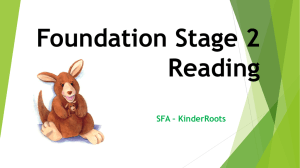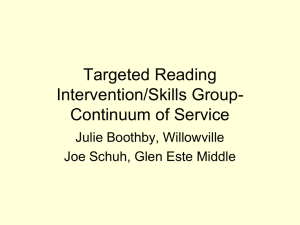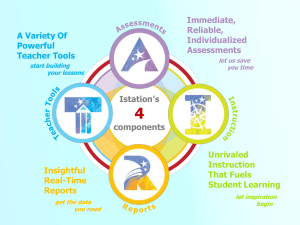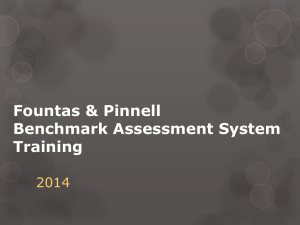Reading Rx PP
advertisement
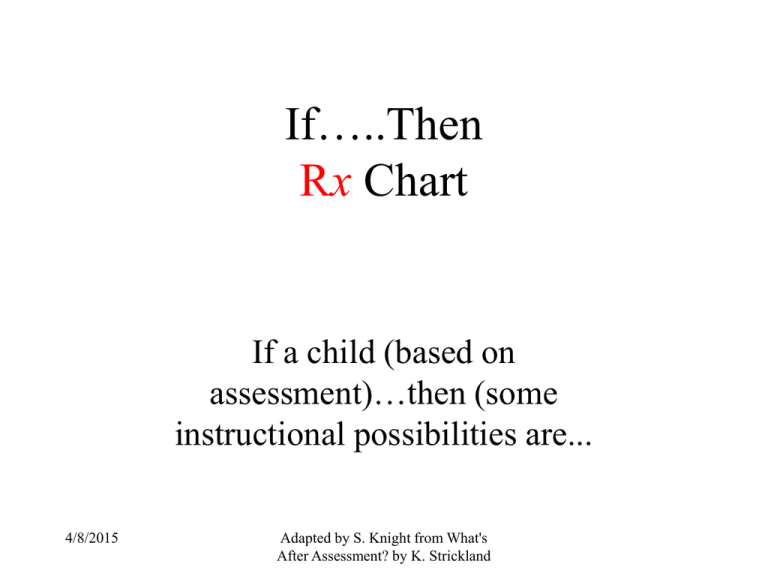
If…..Then Rx Chart If a child (based on assessment)…then (some instructional possibilities are... 4/8/2015 Adapted by S. Knight from What's After Assessment? by K. Strickland Fluency • IF….Student reads word by word • THEN….Teacher – Models fluent reading – Models adjusting reading rate – Uses pre-reading strategies • Pre-telling • Anticipation guides • Webbing • Activate prior knowledge • Set purpose for reading • • • • • • • • • • • AND…. Repeated Reading Timed reading Listening/computer center Reader’s Theatre Environmental Print Reading and writing about their world Choral Reading Echoic Reading Pairs Reading Impress Fluency • IF….Student reads words letter by letter • THEN….Teacher models fluent reading • Teacher helps student see word as a whole • Teacher helps student see word patterns • • • • • • • • • • • • AND…. Word sorts Word walls Alphabet books Personal dictionary Word of the day List-group-share Visual-auditory-kinesthetictactile (VAKT) approach Tracking Cloze Onset/rime Structural Analysis Fluency • IF….Student reads so slowly comprehension is compromised • THEN….Teacher uses pre-reading strategies • Teacher models fluent reading • Teacher ensures text is at appropriate instructional level • • • • AND…. KWL Anticipation guides Set purpose for reading • Activate prior knowledge • Think alouds Fluency • IF….Student reads slowly, but comprehends • THEN….Teacher presents authentic reasons for rereading • Teacher models fluent reading • Teacher presents opportunities to read with support • AND…. • Reader’s Theatre • Writing text for struggling readers • Re-reading • Shared reading • Choral reading • Computer reading • Tape-recorded reading Fluency • IF….Student memorizes text during repeated readings • THEN….Teacher emphasizes paying attention to words in text • AND…. • Work with words using a familiar story or personal dictionary • Scrambled sentences • Tracking with finger • Computer versions of story with highlighted text Fluency • IF…. Student has difficulty tracking or loses place • THEN….Teacher helps student practice reading fluency by using aids that train the eye to process left to right, line by line • AND…. • Computer versions of the story with highlighted text • Tracking with finger • Shared reading • Tracking with a bookmark or other device Rx by Level • Ideas for working with INTENSIVE students to improve in the area of fluency: – – – – – – – Review phonemic awareness Review of alphabetic principle Use of timers and daily reading practice probes More blending and dictation practice More exposure to high frequency words Read along with taped story Word building games (i.e. CVC to develop recognition of spelling patterns) Rx by Level • Ideas for working with STRATEGIC students to improve in the area of fluency: – – – – Form fluency groups Practice with Decodable Text More blending practice Reread anthology stories in small groups with cassettes or computer software – Develop more word attack skills – Choral reading – Poetry reading with partners Rx by Level • Ideas for working with BENCHMARK students to maintain and/or improve in the area of fluency: – Pre-read stories in anthology – Reader’s Theater – Read additional core literature related to unit themes – Timed readings Phonics • IF….Student can decode but uses only letter sounds • THEN….Teacher should model decoding using multiple strategies – Onsets/rimes – Structural analysis – Context clues • • • • • • • • • AND…. Word sorts Cloze Letters & Sounds Segmentation bag Word bank Making words Word families Finding little words in big words • Writing Phonics • IF….Student guesses at words using only initial consonant sound cue • THEN….Teacher should model multiple strategies for decoding • Teacher should present words as wholes • • • • • • • • • • • AND…. Cloze Computer reading programs Language experience Word families Word sorts Word banks Making words Contextual analysis Bag words Writing Phonics • IF….Student has problems with sight words • THEN….Teacher connects words to life experiences • Teacher demonstrates building sight words after reading • • • • • AND…. Word walls Personal dictionaries Bag words Word study after reading • Writing Phonics • IF….Student guesses at unknown words using no graphic cues • THEN….Teacher emphasizes visual aspects of word identification • Teacher models using semantic and syntactic cues • AND…. • Cloze with initial consonant sound • Finding little words in big words • Structural analysis • Onset/rime • Word sorts • Writing Phonics • IF….Student reads known words but stops at every new/unfamiliar word • THEN….Teacher emphasizes all three cueing systems – Semantic – Syntactic – Grapho-phonemic • AND…. • Cloze activities • Use of prediction before and after reading – Possible sentences – Response logs • Guided reading • Think-alouds Phonics • IF….Student has difficulty matching letters with corresponding sounds • THEN….Teacher helps reader realize words are made up of letters that correspond with speech sounds • • • • • • AND…. Counting words in speech Clapping syllables Sound boxes Alphabet sound word examples Word games – match word with beginning letter • Rhyming and rhyming books • Magnetic letters • I-Spy Phonics • IF….Student has little knowledge of the alphabet • THEN….Teacher makes learning the alphabet interesting and fun • AND…. • Songs, nursery rhymes and choral reading • Alphabet books • Letters in names • Alphabet blocks • Alphabet sound word examples • Magnetic letters • Writing letters in shaving crème • Letter detective • Letters in writing Phonics • IF….Student doesn’t recognize new words built on known words • THEN….Teacher focuses on structural analysis • • • • • • • AND…. Word sorts Making words Word families Word games Rhyming words News and announcements chart Phonemic Awareness • IF….Student has difficulty with lettersound correspondence • THEN….Teacher focuses on high frequency letter-sound correspondence (consonants) in the context of real reading situations • AND…. • Letters in context of real reading • Tongue twisters • Nursery rhymes Comprehension • IF…. Student recalls literally and cannot make inferences • THEN….Teacher models how to put pieces of information together • Teacher explains not all information is stated directly • • • • • • • • • • AND…. Think-alouds QAR’s Comprehension strategy framework Literature circles Inferential strategy Response logs Say something Summarizing/retelling CLOZE Comprehension • IF….Student reads quickly but inaccurately and with limited comprehension • THEN….Teacher provides appropriate pace for student • AND…. • DRTA • Comprehension strategy framework • Graphic organizers • QAR’s • Anticipation guide • Guiding reading • Think-Pair-Share • Reciprocal teaching Comprehension • IF….Student reads fluently but misses many details • THEN….Teacher ensures student examines text and re-reads • Teacher discusses story/text with class • • • • • • • • • • AND…. Mapping Webbing Reciprocal teaching QAR’s Context clues, text features Self-questioning Literature circles Think-Pair-Share Linguistic roulette Comprehension • IF….Student reads fluently but cannot identify main idea or purpose • THEN….Teacher brings meaning to the text by connecting to experience and prior knowledge • • • • • • • • • AND…. Story mapping Literature circles Compare & contrast graphic organizers QAR’s Paraphrasing Response logs Summarizing/retelling Artful artist Comprehension • IF….Student reads fluently but cannot retell • THEN….Teacher ensures student know how to retell • Teacher ensures student is constructing meaning while reading • • • • • • • • • • • AND…. Webbing/mapping Interpretive questions Story frames Semantic webbing QAR’s Imagery Predicting Guided reading Reciprocal teaching Directed reading/thinking activity (DRTA) Comprehension • IF….Student has difficulty reading text for information • THEN….Teacher helps student develop techniques for reading non-fiction • • • • • • • • • • AND…. Think-alouds Adjusting reading rate Anticipation guides Reciprocal teaching QAR’s KWL Webbing SQ3R Jackdaws Rx by Level • Ideas for working with INTENSIVE students to improve in the area of comprehension: – – – – – – – – – – – – More ‘easy’ reading and instructional leveled books for student use Classroom libraries designated by instructional levels Listening centers with books on cassette tape Computer centers with books and games on software Teacher focus on comprehension strategies Pre-read story Choral reading to develop fluency and comprehension Experience a wide variety of text in many genres More practice with comprehensible test questions Sight word vocabulary Read Alouds using comprehension strategies Read Alouds that require student response Rx by Level • Ideas for working with STRATEGIC students to improve in the area of comprehension: – – – – – – Teacher focus on ‘RED OCR’ section with comprehension More independent reading at independent reading level Paired reading Sequencing events Vocabulary development Comprehension and writing prompts modeling how to find answers embedded in text – Story maps – Partners write 5 questions each about the current story; trade papers and answer each other’s questions – Students identify the 5 W’s and the H as they read the story Rx by Level • Ideas for working with BENCHMARK students to maintain and/or improve in the area of comprehension: – Continue to monitor comprehension – Ask students to articulate what they are doing when reading to ensure comprehension – Read – Explicitly use reading strategies – Self monitoring – Self correcting – Literature groups with more challenging literature – Confirm and disprove predictions Vocabulary • IF….Student needs to develop a larger vocabulary • THEN….Teacher devises methods to add new words encountered in context to personal reading/writing word bank • • • • • • • • • • • • • • AND…. Word maps Contextual analysis Word games Context-structure-sound-reference (CSSR) Frayer Model Slotting Graphic organizers Visual vocabulary Link and think Word file cards Visual vocabulary Synonym/antonyms Mnemonics Rx by Level • Ideas for working with INTENSIVE students to improve in the area of vocabulary: – Pre-teach vocabulary • Word sorts, Frayer Model, word mapping and webs, structural analysis, think aloud, context clues, making choices, sentence stems, choose between target words, closed sentences – semantic cloze, example/non-example, beat the clock, same format, questions/reasons/examples, juxtaposition, demonstration, etc. – Vocabulary games and worksheets – synonyms, antonyms, multiple meanings, affixes, root words – Sentence extensions (Stretch It) – Develop picture vocabulary – Use of OCR re-teach masters Rx by Level • Ideas for working with STRATEGIC students to improve in the area of vocabulary: – Pre-teach vocabulary • Word sorts, Frayer Model, word mapping and webs, structural analysis, think aloud, context clues, making choices, sentence stems, choose between target words, closed sentences – semantic cloze, example/non-example, beat the clock, same format, questions/reasons/examples, juxtaposition, demonstration, etc. – Create word walls – Games for vocabulary: flashcards, sentence strips – Pictionaries – “Outlaw Word” flashcards, word walls, – Blend words; read; re-read – Teacher continually asks students to make up sentences and extend Rx by Level • Ideas for working with BENCHMARK students to maintain and/or improve in the area of vocabulary: – Pre-teach vocabulary • Word sorts, Frayer Model, word mapping and webs, structural analysis, think aloud, context clues, making choices, sentence stems, choose between target words, closed sentences – semantic cloze, example/non-example, beat the clock, same format, questions/reasons/examples, juxtaposition, demonstration, etc. – – – – – Bingo Lingo Words Alive Jeopardy Words in Motion Word Wizard Issues Outside of the Big 5 • IF….Student has problems choosing appropriate books • THEN….Teacher discusses strategies for selection • Teacher shares instructional/independent reading level with student • • • • • AND…. Reading buddies Sharing books Owning books Library usage Issues Outside the Big 5 • IF….Student has little interest in reading • THEN….Teacher provides opportunities for authentic reading • Teachers emphasizes purposes for reading in life • • • • • • • • • • • • AND…. Environmental print Literacy play boxes Reader’s Theatre Books about me Interactive reading Computer stories or reading games Word games Reading aloud Shared reading Literature circles Jackdaws Issues Outside of the Big 5 • IF….Student has little confidence in reading ability • THEN….Teacher provides opportunities for student to see himself as a reader • Teacher emphasizes reading strengths • • • • • AND…. Read to younger children Reading logs Choosing appropriate books Language experience (reading books written by children) • Choral reading • Shared reading • Set goals & work on them together Issues Outside of the Big 5 • IF….Student pays little attention to print in the world • THEN….Teacher emphasizes the purpose of print • • • • • • • AND…. Environmental print Work with names Reading the room Literacy play boxes Word games Language experience Issues Outside of the Big 5 • IF….Student doesn’t attend to story or attention wanders • THEN….Teacher helps student see reading as a meaningful activity • • • • • • • • • • • • AND…. Interest inventory Reading own writing Writer’s workshop Choosing appropriate books DRTA Reading buddies Think-Pair-Share Literature circles Book reviews QARs Non-fiction strategies (KWL, SQ3R, Structured Note-Taking, etc.) Issues Outside of the Big 5 • IF….Student reads only one genre or one type of book • THEN….Teacher broadens interests and experiences with books • AND…. • Read aloud from various genres • Share books (Literacy Baskets) • Introduce books through book talks • Recommend or suggest a book similar but one step removed (i.e. from Goosebumps to another type of mystery) Issues Outside of the Big 5 • IF….Student has little knowledge of books • THEN….Teacher helps reader feel comfortable with text and book handling • • • • • AND…. Read aloud with child Older reading buddies Owning books Field trips to the library and library cards



